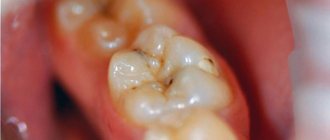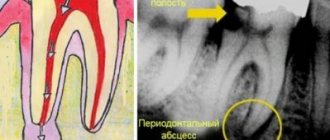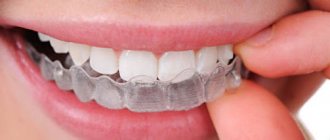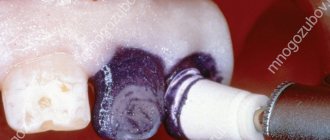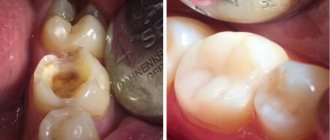Photopolymers for teeth are an innovative achievement in the field of dentistry. A new method appeared relatively recently and quickly became popular due to the low price of photopolymer dental restoration with a large number of advantages. With the help of photopolymers, tooth restoration is carried out in case of various damage to the enamel, the presence of cracks or incorrect location, for color correction, for filling or partial restoration of the shape of the tooth. Sign up for a consultation with specialists at the Omnident clinic in Moscow, and we will restore the beauty and health of your teeth using photopolymer materials.
Methods of artistic restoration
In dentistry, two methods of artistic restoration are used:
- direct restoration – tooth restoration is carried out directly in the oral cavity using composite materials;
- indirect restoration - the technique involves the elimination of various dental defects through the installation of microprostheses.
Photopolymer restoration: features
Light-curing materials in dentistry have a high coefficient of adhesion, practically do not shrink and can withstand heavy loads. Therefore, dental restoration with photopolymers is suitable for almost all teeth. Dentists perform:
- Photopolymer restoration of anterior teeth;
- Teeth extension with photopolymers;
- Filling of chewing and front teeth with photopolymers.
In recent years, a new photopolymer has been developed that has a nanohybrid structure. Fillings made from this composition have a high strength coefficient, and at the same time they are plastic. Thus, restoration of anterior teeth with photopolymer can be implemented even on microscopic cavities, where traditional material cannot hold.
Another advantage of the new method: during installation of a light-curing filling, only the top layers damaged by caries are removed from the tooth. That is, there is no need to drill and injure the tissue once again.
Large fillings are called microprostheses; they correct the appearance, while it is possible to form any shape of the tooth.
Photopolymer dental restoration helps solve many problems of the oral cavity, which is why it is actively developing and is very popular in recent years. At the same time, the price of photopolymer for teeth remains in the average marketing segment. We follow the development of the industry and offer our clients the latest technologies and materials in the dental market. With us you will receive modern treatment at the highest level.
Indications for artistic dental restoration
Aesthetic dental restoration is carried out for such indications as:
- minor damage to dental tissue of carious and non-carious etiology;
- erasing enamel;
- presence of interdental spaces;
- irregularities of the dental row;
- pigmentation of tooth enamel;
- change in the size or color of tooth enamel;
- chips and cracks of enamel;
- pathological mobility of teeth 1, 2 and 3 degrees;
- ineffectiveness of dental treatment by other methods.
During the procedure, specialists at the Bers Clinic in Moscow eliminate tooth defects through the use of certified photopolymer materials.
Advantages and disadvantages
The restoration method using composite materials has its positive and negative sides. Advantages of the technique:
- low cost of the method compared to orthopedic;
- speed of implementation - the procedure is carried out during one visit to the dentist, it is also possible to do several teeth in one visit;
- minimal fabric trimming;
- if there is a chip or channel work is required, correction can be carried out without removing the entire restoration composition;
- effective in the presence of chips, cracks or gaps between teeth.
It is also worth noting several disadvantages characteristic of this technique:
- shrinkage of the composite material, which requires grinding the edges of the restoration at least once a year;
- change in shade over time due to absorption of dyes;
- reduced impact resistance compared to ceramic structures;
- not recommended for use in patients with an installed pacemaker.
Stages of artistic dental restoration
Photopolymer restoration of teeth consists of several stages:
- initial dental consultation;
- professional sanitation of the oral cavity;
- choosing the color of the filling material according to the tone and transparency of natural enamel;
- local anesthesia;
- preparation of dental defects;
- insulating the tooth from moisture;
- installation of a pin (carried out when the tooth is depulped, as well as when the crown is destroyed by more than 50%);
- tooth restoration by layer-by-layer application of photopolymer;
- final grinding and polishing.
If the above steps are carried out accurately, the term of a composite restoration is 5-6 years. The main condition is regular dental examinations in order to early diagnose various pathologies.
Teeth extension
If 20 years ago dentists solved such problems as deep caries, injuries, chips or age-related wear of teeth using a radical method, installing a rough filling, removing the remaining stump or installing expensive dentures, today, thanks to the extension of the frontal/masticatory units, you can easily get your tooth back , even if only its root or stump remains.
When building teeth, the material is selected in such a way that it completely imitates the anatomical features of bone tissue and matches it both in strength, texture and shade.
Before | After |
Over time, modern materials for building crowns do not lose their appearance; only a specialist can distinguish a natural tooth from an extended one. In untreated cases, teeth extension occurs in one session. The service life of the product is about 10 years.
This method cannot be used if, for various reasons, it is not possible to protect the place of work from contact with saliva. Under such conditions, the filling on the front or back teeth will not harden.
Indications
The direct restoration method is used in the area of incisors, canines and premolars to recreate the outwardly healthy appearance of the crown - with an anatomical shape and natural enamel color.
The technique is not suitable for restoring molars, as it is not capable of restoring full functionality to teeth with high chewing load. Main indications:
- cracks and chips;
- partial or complete destruction of the crown as a result of caries;
- the need to replace extensive fillings installed previously;
- obvious change in enamel color, for example, as a result of fluorosis;
- unevenness of the tooth surface, irregular shape of crowns;
- wide spaces between teeth (trema, diastema), mild forms of dystopia;
- pathological thinning of tooth enamel.
If necessary, this method allows you to completely reconstruct the lost coronal part (with the entire root), however, for a reliable result, it is desirable to have at least 50% healthy tissue.
When is recovery required?
Modern dentistry offers restoration of the aesthetics of the dentition and the full functioning of damaged or lost units. Often the need for such treatment arises when there is deep caries damage. This insidious disease is not always distinguishable at the first stage, which leads to the destruction of a significant part of the crown.
Additional Information. Dentists recommend not to delay in treating caries. The deeper the disease penetrates, the more difficult recovery will be.
Another reason for dental restoration is trauma. Most often, as a result of strong mechanical influences, there is a need to restore the front teeth. The need for dental restoration often arises also due to non-carious diseases. Failure to promptly seek help in restoring the beauty of your smile can lead to the acquisition of persistent complexes and neuroses.
Fiberglass: pins and tires
Pins make it possible to strengthen teeth with extensive tissue loss. They are installed in the root canal, after which they become an addition to the remaining walls. After restoration, teeth with a voluminous extension will be able to withstand heavy loads. A pin core insert is used to install a ceramic crown.
What about the increasingly popular fiberglass pins? The main advantages of the material: restored teeth look natural and withstand significant loads, allergic reactions are excluded. Fiberglass is also used for splinting loose teeth, where material properties such as strength, light transmission and proximity to the color of enamel are especially important.
Features of using tabs
Inlays in dentistry are custom-made prostheses made in the laboratory that are used to restore the anatomical shape of the “bone” part (crown) of the teeth. This requires plaster casts of the lower and upper dentition. This restoration method is used only for lateral teeth.
The inlays are made of durable materials that fully match the color of the crown. After restoration, they remain almost invisible and do not cause any discomfort, repeating the anatomically correct shape of the lost part of the tooth. The tab is installed using a special adhesive composition. This method requires a lot of time, but guarantees excellent results.
Features and stages of extension to a pin
Restoring a tooth crown when a significant part of it has been lost will not have a lasting effect without the use of a pin. This element is made of durable materials (steel, titanium, palladium, carbon fiber, fiberglass) and serves as the basis for extensions. The part restored with photopolymer is securely fastened to the pin, ensuring the reliability of the structure even under significant loads.
Important! Bruxism (grinding in your sleep) and lack of roots are direct contraindications to building teeth with pins.
Stages of extension onto a pin:
- Cleaning, processing and expansion of canals.
- Insertion of a pin with fixation of its edge in the bone.
- Filling the canal with pin fastening.
- Attaching an artificial crown or layer-by-layer application of layers of photopolymer to recreate part of a tooth.
Additional Information. If only the root remains of the tooth, it is possible to avoid implantation using pinning. In this case, restoration of the tooth stump for further installation of the crown is carried out on the outer edge of the pin.
Restoring teeth with fiberglass
Restoration using fiberglass technology helps eliminate various imperfections and defects of teeth and preserve their beauty.
Before | After |
Fiberglass has high aesthetics and is a modern, reliable, absolutely safe and very durable material, thanks to which new teeth not only look natural against healthy ones, but also become stronger. The fact that fiberglass does not stain or change its original color throughout its entire service life indicates that this material is high-quality and indispensable in restoring dental health.
Fiberglass is widely used in carrying out
:
- splinting mobile teeth;
- dental recession during post-orthopedic treatment;
- restoration of special prostheses.
In addition, the advantage of restoring teeth with fiberglass is that it is a gentle method, since there is no need to depulpate the supporting teeth and in one visit to the doctor you can restore all the teeth directly in the oral cavity.
